Desk jobs are already predominantly sedentary — but throw in working from home and suddenly you’ve cut out the extra steps you took walking to your car, into the office, to your desk, and, back home again. That might not seem like a lot, but all of those lost steps add up.
A work-from-home client of mine once noted with surprise that she barely made 1,000 steps by dinner time. This is a reality for many of us these days, even if we’ve got the best treadmills out there waiting for us at the gym. How can we counter this unconscious sedentary lifestyle? Enter the treadmill desk. Here are the pros (and cons) of working on a treadmill, informed by our fitness experts.
Editor’s Note: The content on BarBend is meant to be informative in nature, but it should not be taken as medical advice. When starting a new training regimen and/or diet, it is always a good idea to consult with a trusted medical professional. We are not a medical resource. The opinions and articles on this site are not intended for use as diagnosis, prevention, and/or treatment of health problems. They are not substitutes for consulting a qualified medical professional.
What Is a Treadmill Desk?
A treadmill desk is pretty much what it sounds like. It’s a workstation that combines an under-desk treadmill or walking pad with a standing desk. Users typically operate the treadmill at a slow pace, around 2 to 3 miles per hour (mph), which helps maintain focus on their work while sneaking their steps in — all without leaving the desk.
Who Should Work on a Treadmill
According to certified personal trainer John Holt, working on the best under-desk treadmills can be a huge asset to your health. “Simply getting in 10,000 to 12,000 steps a day can improve fitness and promote a healthy weight,” he explains. He finds this to be of tremendous value simply from a standpoint of physical health, but he also thinks it has the potential to stimulate mental productivity during work hours.
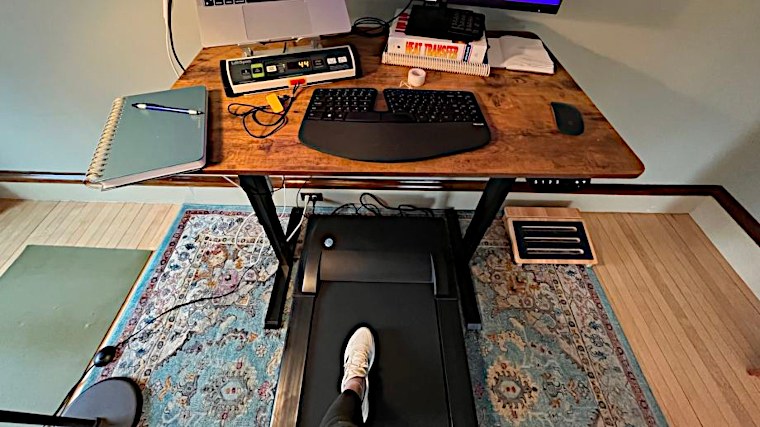
“Studies show that the simple act of getting up from your desk and taking a short walk can help trigger ideas, with one study finding that creative output increased quite substantially when participants were walking, even when they were on a treadmill facing a blank wall,” adds Holt. (1)
- Work From Home Folks: If you work from home and, therefore, can design your space however you like, this could be a great addition to your workspace.
- Those in Lectures or Conference Calls: It’s easy to get some light movement in with a treadmill desk while listening in on work meetings or school lectures. Just don’t forget to put yourself on mute!
- Multitaskers: A treadmill desk can improve your productivity, especially if you’re great at walking and working at the same time.
- Those with Jobs Where It’s Difficult to Leave Your Desk: Those who can’t leave their desk for long periods at a time may find it difficult to add movement into their day, but a treadmill desk makes it possible.
- Individuals with Sedentary Habits: Watching TV or making phone calls to friends is often done on the couch, but it’s easy to do both on a walking pad, allowing you to continue your normal activities while sneaking steps in.
Who Should Not Work on a Treadmill
While a treadmill desk might boost the productivity of some people, certified personal trainer John Holt points out that it can be a hindrance to others. He says this is especially true if they have injuries that are likely to cause them pain while walking.
[Related: Are Walking Pads Worth It? What to Consider Before Buying]
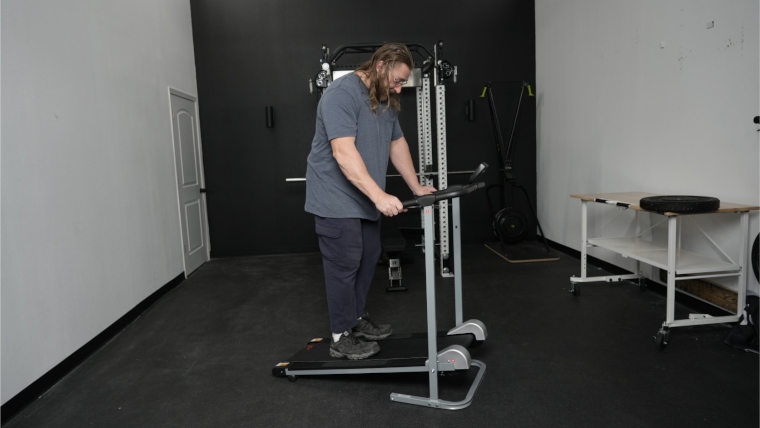
“Even with extra cushioning or specialized shoes, the act of walking might still cause joint pain in your ankles, knees, or hips,” explains Holt. “If you’re in an office, the motors, the rotating belt, and the sounds of walking can all contribute to the noise from a treadmill, which may create a disturbance or distraction in a work environment. Some people may also have trouble walking and doing the technical or delicate tasks their work requires.”
- Office Workers: If you work in an office where you can’t control your workspace, you may not have the option of using a treadmill desk. Because it’s a public space, it may be distracting to other employees or there may not be space for it.
- Individuals with Poor Balance: If you aren’t the best at balancing — either physically or mentally — while multitasking, this might not be a good option for you. The split focus of working and walking simultaneously requires decent balance. If this is you, work on your coordination before considering a treadmill desk.
- Runners: Treadmill desks aren’t built for running. Not only is it harder to multitask while running, but under-desk walking pads aren’t built to sustain high-intensity cardio. If that’s what you’re looking for, consider one of the best treadmills for running instead.
- People who Experience Wrist Pain: If you have wrist pain, you may find the unevenness of walking while working exacerbates any pain you are already experiencing.
How to Work on a Treadmill
OK, but how the heck do you type while walking, anyway? Here’s what to expect (and how to get your steps and emails in).
Anticipate a Learning Curve
You will need to anticipate a learning curve as you begin to use your treadmill desk. New users report that their productivity decreases when they first start to walk and work. (2) Start slow, be patient, and be aware that you will experience an adjustment period before seeing all the benefits of working with a treadmill desk.
Maintain Good Posture
Be mindful of your posture while you walk and work. It’s easy to slip into a hunched posture when you aren’t consciously aware of your form. Keep your core engaged and shoulders back while you walk or you could create some back or pain for yourself.

Upright posture also relies on the height of your standing desk. Adjust your desk to a height where your arms are at a 90-degree angle and level with the table. Otherwise, you may experience either neck pain from hunching over to look at your screen or wrist pain from positioning your arms at an awkward angle.
Take Regular Breaks
If you’re a beginner, start slow by walking for short periods of time, about 15 to 20 minutes, as you get accustomed to walking while working. Once you get more comfortable and fall into a routine with your own treadmill desk, you can walk and work for more extended periods.
Taking breaks will allow you to organize your work tasks into blocks, dividing activities up by what you can do while walking and which are better suited for sitting. This will help break up the day and help time fly as you get your work done.
Wear Comfortable Shoes
Make sure that your shoes give you the support you need to walk on a treadmill. By the end of the day, your feet will be yelling if you aren’t wearing comfortable shoes. The best running shoes can be used for walking, too, and they will support your feet and ankles so that you can walk throughout the day comfortably.
Wear Your Fitness Tracker on Your Ankle
Your fitness tracker might not pick up that you’re walking if your hands are lying flat on a desk while you work. If tracking steps is important to you, place your tracker on your ankle or get a belt pedometer to get a more accurate step count during your workday. It may sound silly, but it’s an effective way to keep track of that data.
Benefits and Drawbacks of Working on a Treadmill
If you’re the type to need a pros and cons sheet, I’ve got you covered.
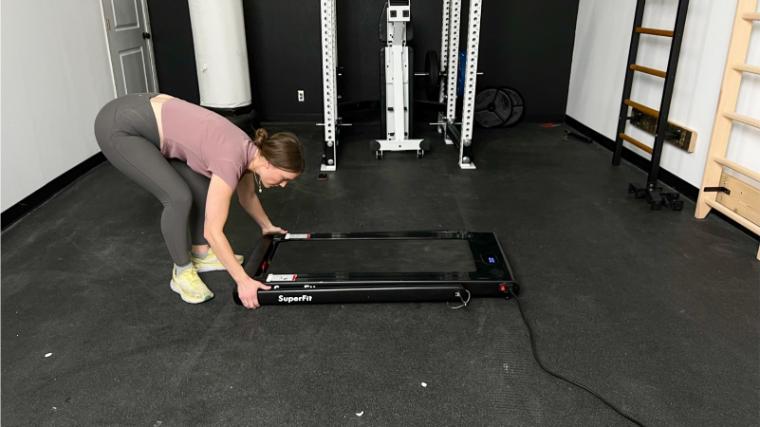
Benefits of Working on a Treadmill
- Increased Step Count: According to the American Health Association, 80% or more of jobs in the United States are mostly sedentary. (3) If that includes your job, it’s especially important to combat sedentary behaviors by adding conscious movement into our day. Treadmill desks are one way to add steps to your workday while continuing to get your work done.
- Reduced Risk in Cardiovascular Diseases: By adding steps into your day with a treadmill desk, you could see significant health benefits. Having good cardiovascular health means you are less at risk for various conditions like obesity, heart disease, or, stroke. Studies have also shown that your lifespan can increase by improving your cardiovascular health. (4)
- Fewer Aches and Pains: The benefits of walking extend to pain prevention, too. Research shows that walking throughout the day can combat any general soreness or stiffness you may experience from sitting for long periods. Adding light movement to your day can also reduce back, knee, or hip pain. (5)
- Increased Productivity: Research suggests that walking treadmills may increase focus and cognitive function, making users more productive at work. (5) While you walk, blood flows to your brain and can help you think more clearly and efficiently, which allows you to get more done.
- Improved Mood and Energy Levels: As an additional side-effect, walking while you work can have a big impact on your well-being, too. Walking improves your mental health and increases your energy levels. (5) As the ever-wise Elle Woods taught us: “Exercise gives you endorphins. Endorphins make you happy.”
- Improved Quality of Sleep: Getting at least 30 minutes of activity a day has been shown to improve your quality of sleep. The added movement can help with sleep disorders like insomnia and sleep apnea. (6)
- Potential Weight Loss: While weight loss is not a pro for everyone, if it’s one of your fitness goals, you may be able to set yourself up for it here. Typically, you are moving at a slow pace on a treadmill desk to allow for effective multitasking. Because of this, weight loss is not a primary benefit; however, you are still adding steps into your day, which can contribute to overall calories burned, resulting in possible weight loss.
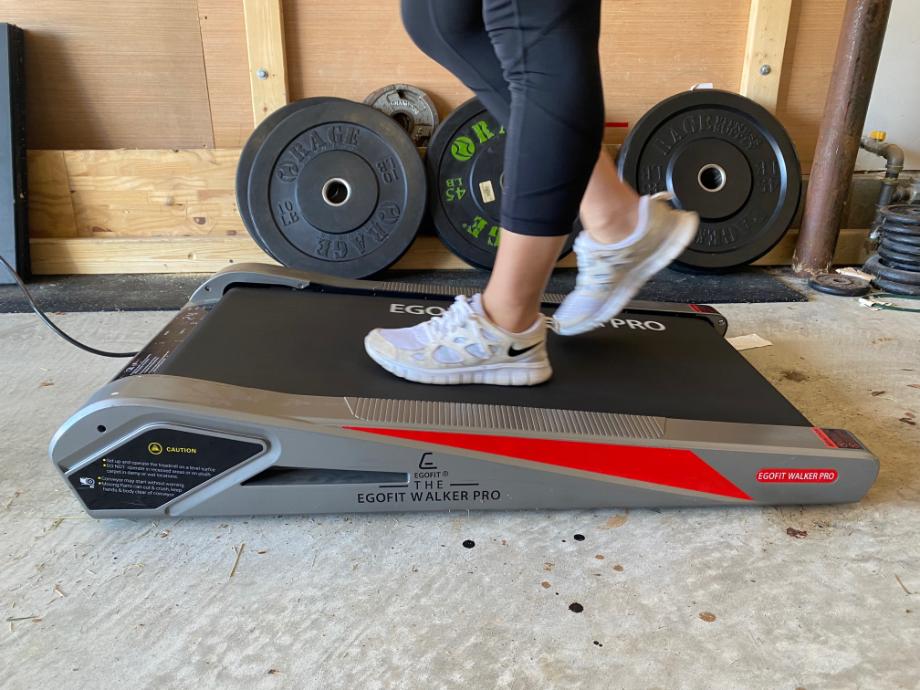
“Anyone who is looking to get more physical activity in their day-to-day activities can benefit from a treadmill desk, as can someone who discovers that by moving while walking, they are able to think more clearly, be more creative, and therefore be more effective at their job,” explains John Holt, certified personal trainer.
[Related: Best Cushioned Treadmills]
Drawbacks of Working on a Treadmill
- Cost and Space Requirements: Not everyone has a home office and not all spaces are set up to make room for a walking desk. You need space to fit the walking pad under your desk as well as a place to store it while it’s not in use. Plus, treadmills and walking pads are an investment—they may not be a viable option for everyone.
- Possible Noise Pollution: Many users have reported a distracting noise while using treadmill desks, particularly at higher speeds or while inclined. (4) If you’re in a communal office space, have downstairs neighbors, or participate in a lot of meetings, this could be a nuisance to others. Be sure to check the reviews before you purchase one if you need a quieter option.
- Moving Workspace May Take Up Time: You likely want to break up your day with periods of walking and sitting at your desk, so unless your desk height is easily adjustable, factor in the time you will need to shift your workspace. Switching between your standing and sitting workspace can be a hassle, especially if you have lots of things to rearrange.
- Possible Incompatible Tasks: Some tasks may not be cut out for walking while working. Specifically, you may find it difficult to click accurately with your mouse or enter data in Excel spreadsheets while walking.
- Less Time Outdoors: Because you’re getting your steps inside, you may be less likely to walk outside, which has tremendous benefits. Vitamin D is essential for bone and muscle health as well as your mental health, and you won’t be getting any by walking inside!
- Low Weight Limit: Many walking pads have weight limits as low as 220 pounds. Keep this in mind when you’re shopping around.
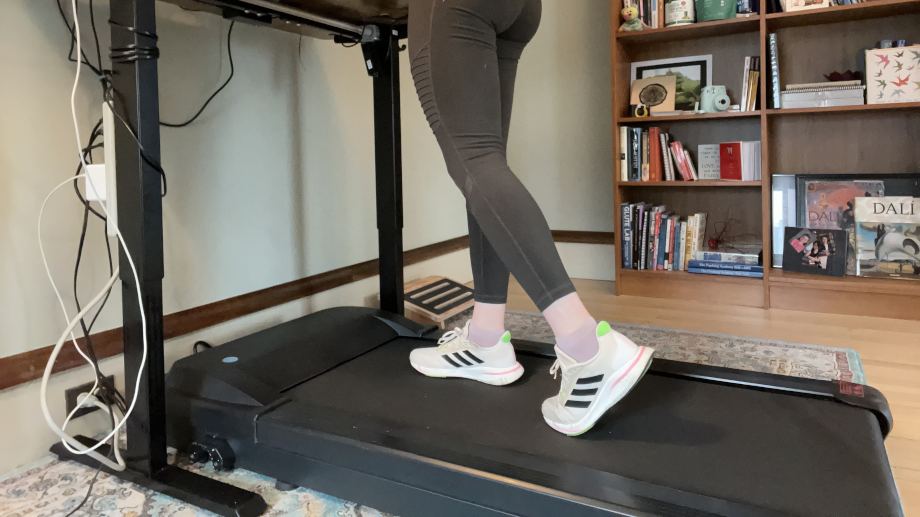
On top of these drawbacks, failing to maintain good habits while walking on the treadmill can lead to other types of problems down the line. That’s why Holt encourages you not to sacrifice your walking form for the sake of being able to work while on a treadmill.
“Always stay standing tall while keeping your spine straight and shoulders relaxed,” instructs Holt. “Look ahead — not down — to avoid neck strain. Swing your arms freely from the shoulders, not the elbows. Step lightly, rolling from heel to toe. Maintain a neutral pelvis, and avoid excessive arching or tucking.”
[Related: Best Treadmills for Heavy People]
What to Consider Before Buying a Treadmill Desk
You probably don’t want to make a purchase like this on a whim. Here are the factors to take into account before you hit “check out.”
Map Out Your Workspace
Ergonomics is key here. Have a space in mind for your treadmill desk setup before you get it so that you know exactly where it’s going and how you’ll store it. Find the walking pad’s measurements to ensure it fits in your workspace. Treadmills also work best on flat surfaces like wood floors, so if your space is carpeted, it will create an unstable surface for your walking pad.
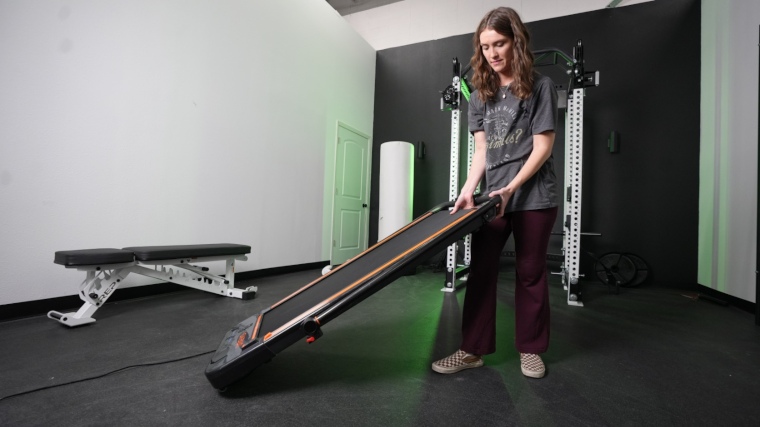
Your walking pad should be placed near a free outlet. Like most motorized exercise equipment, they require more power and electricity than many common household appliances, especially when operating at higher speeds or inclines. Plugging them into an outlet that already has other things plugged into it can cause the circuit breaker to trip.
Weight Limit
One of the most important factors to consider when buying a treadmill is the machine’s weight capacity. Walking pads have weight limits, so keep that in mind while shopping for one. Many can support up to 220 pounds but some can hold more. Walking pads are not as structured or as sturdy as a traditional treadmill, so keep that in mind while you look at options.
Compatibility With Work Style
Depending on your job requirements, you may find that a treadmill does not increase your productivity. It’s important to be self-aware of what you need to get done and how you can best make that happen. Many users find that treadmill desks work well for listening to lectures or meetings, responding to simple emails, reading, or browsing the Internet.
Participants in a recent study reported that tasks requiring fine motor control like typing or using a mouse were difficult while walking, as was anything that required deep thinking or concentration. Even giving presentations on camera during a meeting was found challenging. (4)
Work Vs. Workout
If you’re looking for something to run on, this might not be the right piece of exercise equipment for you. Some walking pads can get up to around six mph, but that’s not the most practical while trying to work (or run very fast).
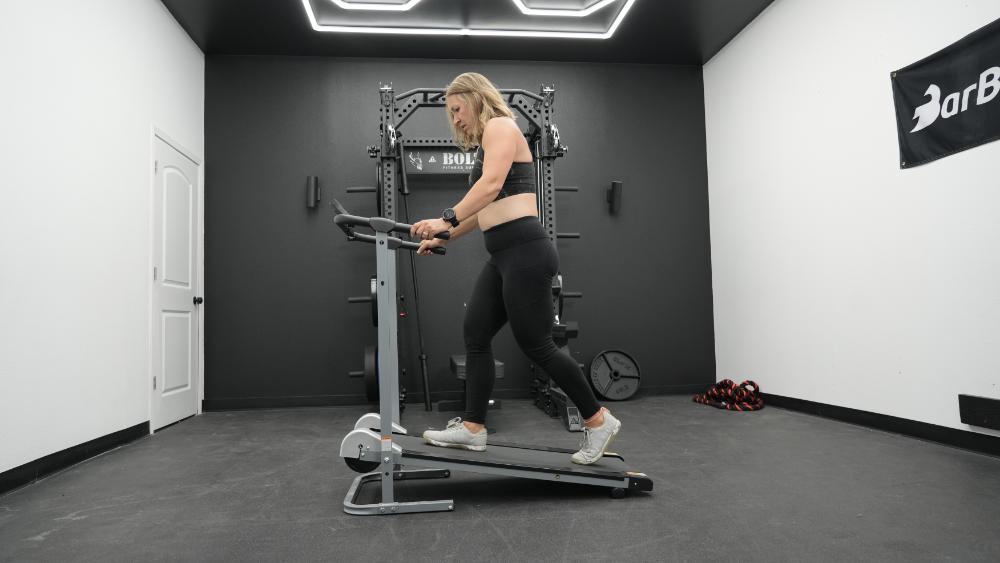
The structure of the walking pad is much better suited for a walking speed, which is ideal for multitasking while you work, or — as the TikTok trends call it — “cozy cardio,” which consists of watching TV or calling friends while walking in your comfy clothes in the comfort of your own home.
Working on a Treadmill FAQs
Are walking pads worth it?
Walking pads can be 100% worth the investment if you’re seeking a way to add steps into your workday or while doing activities that are typically sedentary like watching TV. Additionally, if you live in an area where it’s hard to walk outside like places with extreme weather or without sidewalks, it can be a more affordable option than getting a full-fledged treadmill.
How does a treadmill desk impact productivity at work?
Studies suggest that using a treadmill desk can improve your productivity. (4) Once you figure out the learning curve that comes with walking and working simultaneously (during which time you might notice a decrease in work production), you will be able to discern which activities you can perform on the treadmill and which aren’t ideally suited for it. Exercising helps with blood flow which helps improve cognitive function. This helps you work more efficiently and with better focus allowing you to get more done throughout your work day.
Is it hard to work with a desk treadmill?
In the beginning, you may find it hard to use a treadmill desk, but over time it becomes easier to use as you learn what works for you. Everyone is different, but most people walk at a slow pace of two to three mph and choose specific tasks that they can perform while walking.
How long should you walk on a desk treadmill?
It depends on your fitness level and your fitness goals. Start small, walking for 15 minutes at a time. As you get situated, you can increase the duration of your walks. A common goal is breaking up one to three hours of walking per workday. Always listen to your body and be honest with yourself. If you find it’s helping you stay focused and get work done, then keep going. If not, then maybe it’s time to take a break.
References
- Oppezzo M, Schwartz DL. Give your ideas some legs: the positive effect of walking on creative thinking. J Exp Psychol Learn Mem Cogn. 2014 Jul;40(4):1142-52. doi: 10.1037/a0036577. Epub 2014 Apr 21. PMID: 24749966.
- Ben-Ner A, Hamann DJ, Koepp G, Manohar CU, Levine J. Treadmill workstations: the effects of walking while working on physical activity and work performance. PLoS One. 2014 Feb 20;9(2):e88620.
- Gremaud AL, Carr LJ, Simmering JE, et al. Gamifying Accelerometer Use Increases Physical Activity Levels of Sedentary Office Workers. J Am Heart Assoc. 2018;7(13):e007735. Published 2018 Jul 2.
- Katzmarzyk PT, Lee IM. Sedentary behaviour and life expectancy in the USA: a cause-deleted life table analysis. BMJ Open. 2012 Jul 9;2(4):e000828.
- Scisco JL, Meyers E, Miceli A, Powell J. “It’s Been a Game Changer”: Examining Treadmill Desk Use When Working from Home. Occup Health Sci. 2023 Jan 28:1-22.
- Alnawwar MA, Alraddadi MI, Algethmi RA, Salem GA, Salem MA, Alharbi AA. The Effect of Physical Activity on Sleep Quality and Sleep Disorder: A Systematic Review. Cureus. 2023 Aug 16;15(8):e43595.